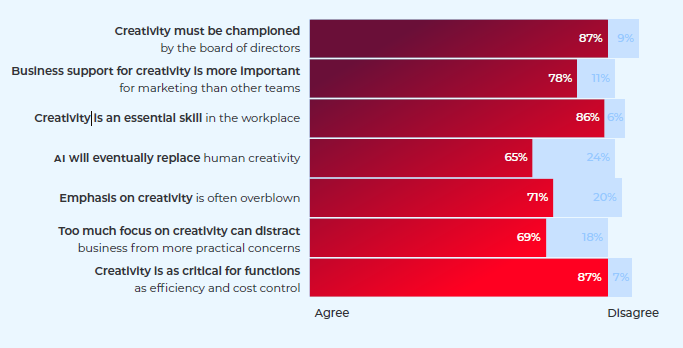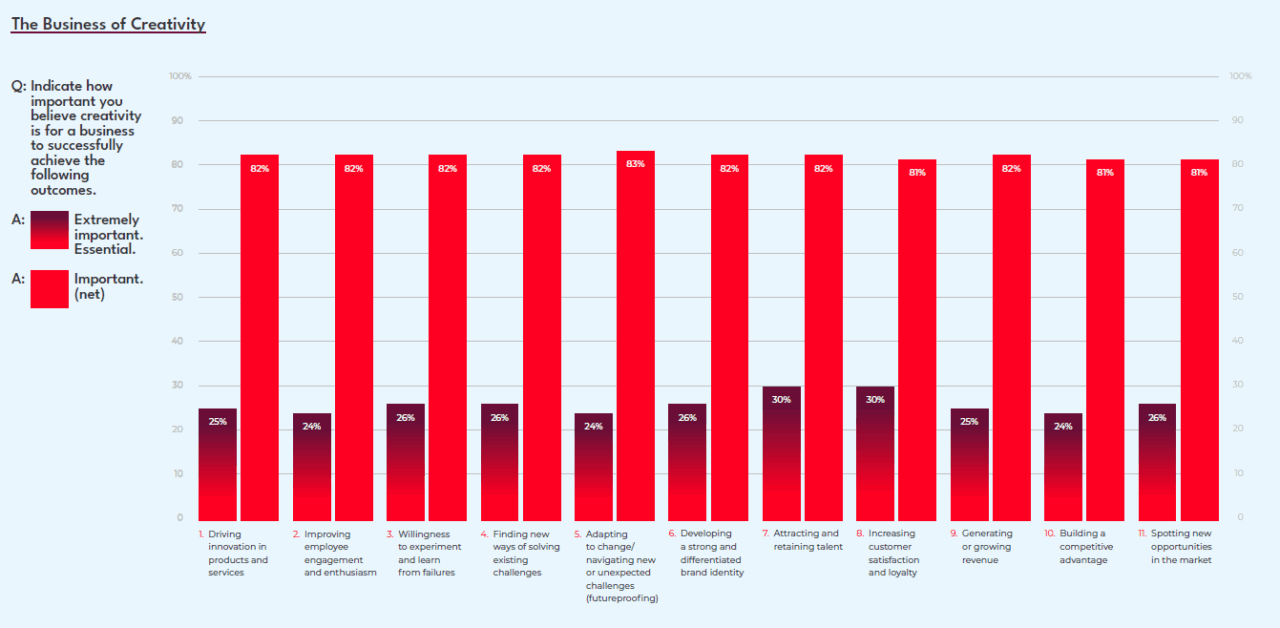This year marks a symbolic anniversary—150 years since the first documented use of the word “creativity” in English. Historian Adolphus William Ward used the term in 1875 in connection with William Shakespeare’s “poetic creativity.” Today, the importance of creativity across all fields, including the media industry, is undeniable. According to Sir John Hegarty, who took part in the preparation of The Business of Creativity, creativity is vital for human progress because it shapes culture, drives business, strengthens empathy, and gives meaning to human existence.
Key findings of the TBOC report
The authors of The Business of Creativity (TBOC) report introduced the term “creative leap,” which refers to a significant breakthrough in history, whether it’s a global achievement (such as the introduction of the internet) or a breakthrough in a personal sphere or a company’s life. The report identifies six key “creative leaps”:
- Driving global growth despite turbulence: the digital economy is expected to reach a value of $16.5 trillion by 2028 (17% of the global GDP), and the number of patents in Europe reached a record 199,275 in 2023.
- Entrepreneurship upsurge: a record number of new businesses in the USA (5.4 million in 2023) and the UK (850 thousand newly registered companies in 2024).
- Creative industries: In the UK, the creative industries contributed £124 billion in 2023 (5.2% of GDP), but in 2024, a slight decline in both employment and gross value added was recorded.
- Flourish - or decline: Brands with creativity in their DNA (such as Apple, Google, Waymo) are growing; however, only 13% of companies consider themselves “creative risk friendly.” Companies lacking creativity risk decline.
- Creators rule commerce: According to Deloitte estimates, around 50 million creators produce content for 5 billion social media users; social commerce is anticipated to be worth $2 trillion by 2026.
- AI tension: 69% of executives believe that AI will increase the importance of human creativity; the generative AI market is expected to grow to $1.3 trillion by 2032.
Creativity in business
A survey of 450 executives from the US, UK, and Singapore revealed that 87% consider creativity to be just as essential as efficiency and cost control.
 Source: The Business of Creativity
Source: The Business of CreativityCreativity is seen as a crucial factor for product and service innovation, employee engagement, willingness to experiment and learn from failures, finding new ways of solving challenges, adapting to change, developing brand identity, attracting and retaining talent, growing revenue, building a competitive advantage, and spotting new opportunities in the market.
 Source: The Business of Creativity
Source: The Business of CreativityHowever, several “creativity gaps” were also identified — relating to geography (e.g., executives in the U.S. are more optimistic than their counterparts in Singapore), generations (younger leaders place more faith in a culture of ideas, while older ones take a more cynical view and are more aware of the related challenges and pitfalls), and attitudes (even though 86% of people acknowledge the immense importance of creativity, 71% of executives say that creativity is often overemphasised).
How to make the next creative leap
Creativity requires courage, ambition, and optimism. The right structure and tools can help companies foster these qualities within their teams. The report concludes with three practical steps that can help companies achieve their next creative leap:
- Creative leap audit: determine, through discussions among senior leaders, how many creative leaps the company has made (or at least attempted) and how many bold ideas are being implemented within the company.
- Internal survey: use the TBOC methodology to measure creativity within the organisation.
- Reconnection to the founding creative philosophy: share the company’s original creative story. Cultural change begins with storytelling, and creativity thrives when people are reminded of what they are here to build.
Creativity is the key to growth
Creativity is not just a pleasant add-on. It is a strategic pillar of growth and innovation and an essential factor contributing to the resilience of companies. In today’s era of artificial intelligence and geopolitical turbulence, human imagination represents a decisive competitive advantage. Developing it requires proper leadership from management, targeted cultivation of corporate culture, measurement of results, and a considerable willingness to take risks.
Cultivating ambition is vital. Teams that understand the significance of their work will over-deliver. Great works of art have ambition. Your business should too.
Sir John Hegarty, Creative Director, The Business of Creativity
The topic of creativity will also be featured in the webinar The Case for Creativity, which Sir John Hegarty will present on 24 September 2025, in collaboration with Orlando Wood. The webinar is free, and you can register here.

